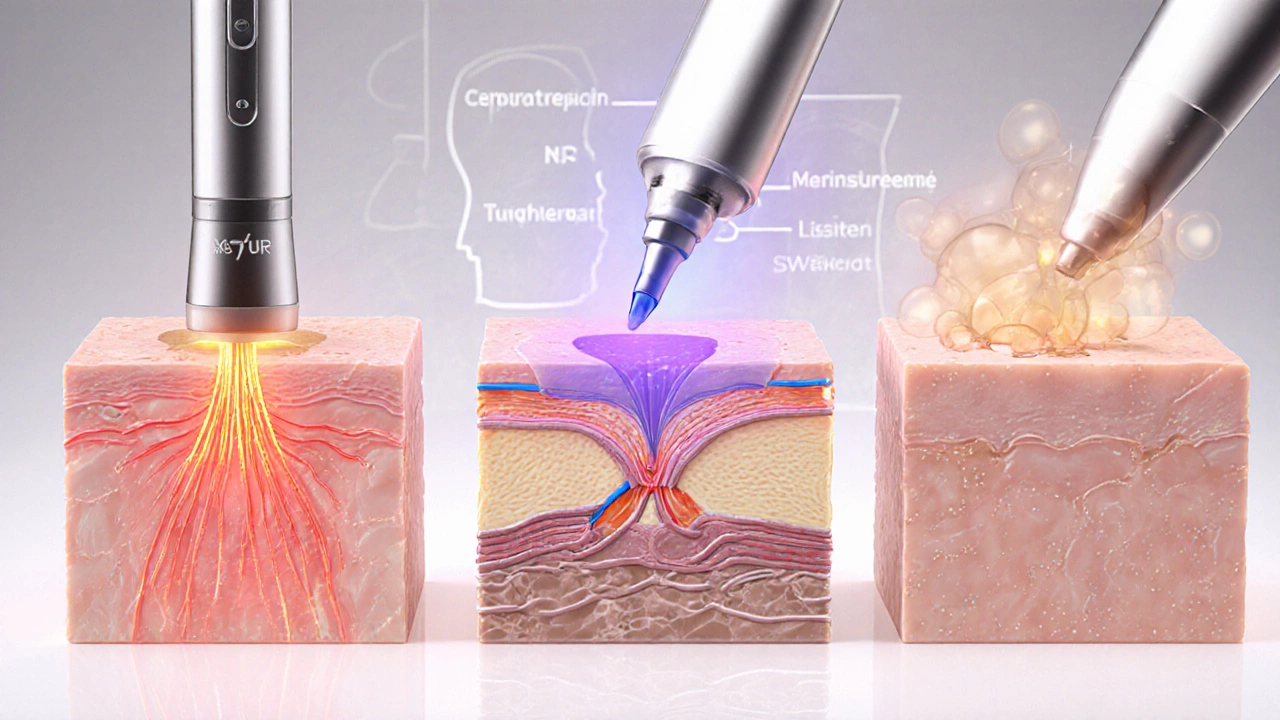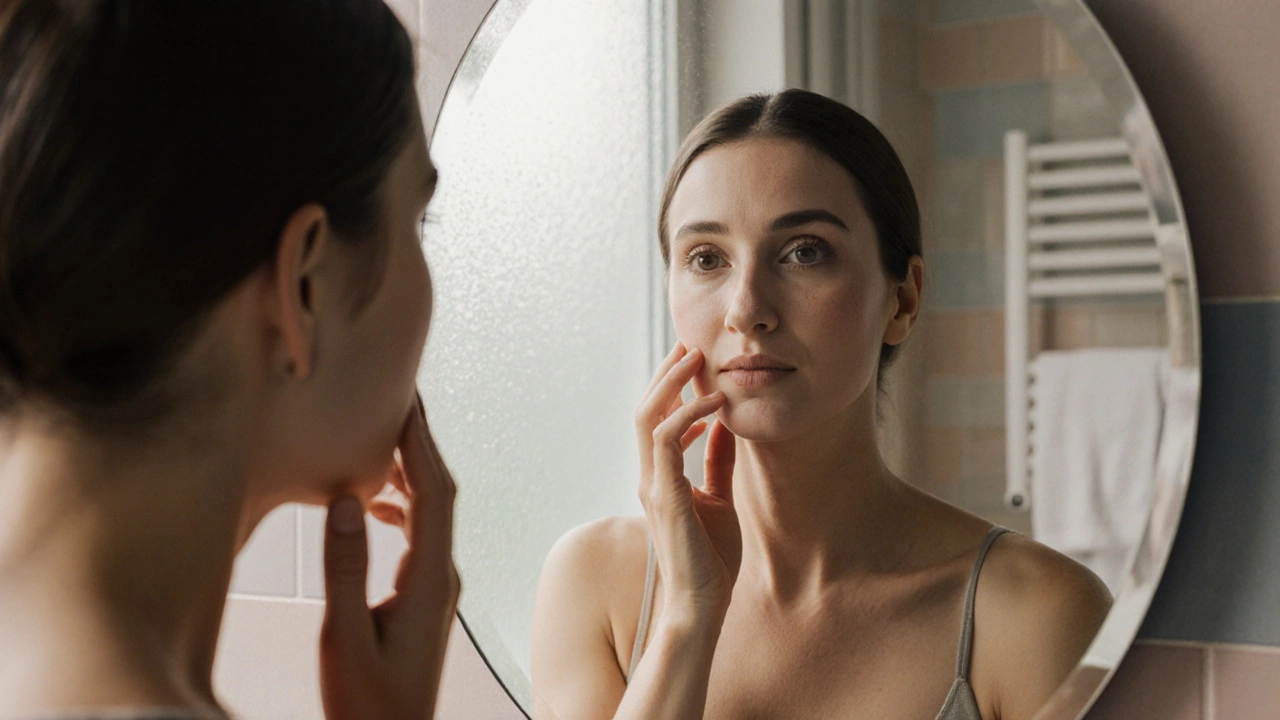Facial treatments for sagging skin are a group of non‑surgical procedures that aim to tighten loose facial tissue, boost collagen, and restore a firmer appearance. If you’ve stared at a mirror and noticed the jawline softening or cheekbones losing definition, you’re probably wondering which option actually works without a scalpel. This guide walks you through the science behind sagging skin, the factors you should weigh, and the top‑ranked treatments that deliver real lift in 2025.
Key Takeaways
- Radiofrequency (RF) and micro‑focused ultrasound (Ultherapy) give the most dramatic lift with minimal downtime.
- Microneedling with RF combines collagen induction and heat, making it a solid mid‑budget choice.
- Chemical peels and LED light therapy improve skin texture but offer only modest tightening.
- Choose a treatment based on skin thickness, budget, recovery time, and desired results speed.
- Post‑procedure care - sunscreen, hydration, and gentle exfoliation - maximizes and prolongs results.
Why Does Facial Skin Sag?
As we age, two key processes undermine facial firmness:
- Collagen breakdown: Production drops by about 1% each year after age 20, weakening the scaffold that holds skin up.
- Loss of elastin and hyaluronic acid: These molecules give skin its bounce and plumpness. When they dwindle, gravity takes over.
External factors - sun exposure, smoking, and rapid weight fluctuations - accelerate the decline. The result is a visible sag, especially around the jawline, temples, and under‑eye area.
How to Pick the Right Facial Treatment
Before you book an appointment, run through this quick checklist:
- Invasiveness: Are you comfortable with needles or heat devices?
- Downtime: Do you need to return to work within a day?
- Cost per session: High‑tech options can run $1,500‑$3,500 per treatment.
- Results timeline: Some treatments show lift after 2‑4 weeks, others need multiple sessions.
- Skin type compatibility: Darker skin tones may be more prone to hyperpigmentation with certain lasers.
Match your answers to the profiles below.

Top Facial Treatments in 2025
Each option is described with its core mechanism, typical session length, and who benefits most.
Radiofrequency (RF) therapy uses controlled thermal energy to heat the deep dermis, stimulating new collagen production. Sessions last 30‑45 minutes, and most clinics recommend 3‑4 treatments spaced a month apart.
Ultherapy (micro‑focused ultrasound) delivers focused ultrasound waves that reach the SMAS (superficial musculo‑aponeurotic system) layer, the same tissue tightened during a surgical facelift. Results appear gradually over 2‑3 months.
Microneedling with RF combines traditional microneedling channels with RF heat, giving a double‑boost to collagen. Ideal for patients who want moderate lift plus improved texture.
Chemical peel (medium‑depth) exfoliates the outer layers and triggers a mild inflammatory response that renews collagen. Best for early‑stage sag when texture is also a concern.
LED light therapy (particularly red/near‑infrared wavelengths) boosts cellular metabolism and promotes collagen synthesis without any heat or needles. It’s a low‑cost, zero‑downtime maintenance tool.
Laser skin tightening (fractional non‑ablative lasers) heats the dermis in a pixelated pattern, causing immediate collagen contraction and long‑term remodeling.
Facial massage & facial yoga stimulate blood flow and encourage lymphatic drainage, offering a modest temporary lift when practiced daily.
Topical retinoids increase cell turnover and boost collagen over weeks, making them a complementary at‑home option rather than a standalone lift.
Comparison of Popular Treatments
| Treatment | Invasiveness | Typical Downtime | Cost (USD) | Results Onset | Best For |
|---|---|---|---|---|---|
| Radiofrequency (RF) therapy | Low‑moderate (heat device) | Same day (redness ≤24h) | $800‑$1,500 per session | 4‑6 weeks | Mid‑to‑late 30s, mild‑to‑moderate sag |
| Ultherapy (micro‑focused ultrasound) | Low (ultrasound probe) | Same day (minor swelling) | $1,800‑$3,500 per session | 2‑3 months | Deep‑layer lift, surgical‑like tightening |
| Microneedling with RF | Moderate (needles + heat) | 1‑2 days (crusting) | $600‑$1,200 per session | 4‑8 weeks | Combined texture + lift |
| Medium‑depth chemical peel | Moderate (acid application) | 3‑5 days (peeling) | $300‑$700 per session | 1‑2 weeks | Early sag + uneven tone |
| LED light therapy | None (light panels) | None | $100‑$250 per device or $50‑$100 per clinic session | 6‑12 weeks (cumulative) | Maintenance, sensitive skin |
| Fractional non‑ablative laser | Low‑moderate (laser pulses) | 1‑2 days (redness) | $1,200‑$2,200 per session | 6‑8 weeks | Firming plus resurfacing |
| Facial massage & yoga | None | None | Free‑$150 for classes | Immediate (temporary) | Daily upkeep, low budget |
| Topical retinoids | None (cream/gel) | None | $30‑$120 per month | 8‑12 weeks | Home maintenance, early signs |

Best Treatment for Different Scenarios
Looking for the most dramatic lift with minimal downtime? Ultherapy tops the list - it reaches the deepest facial layer without incision.
If you have a moderate budget and want both texture improvement and tightening, microneedling with RF offers the best bang‑for‑buck.
For early‑stage sag and a tight wallet, start with a medium‑depth chemical peel combined with nightly retinoids.
When you can’t spare any recovery time, radiofrequency panels at a medical spa give visible tightening in under an hour.
Finally, for a lifelong maintenance program, schedule LED light sessions monthly and practice facial yoga daily.
After‑Care Tips to Preserve the Lift
- Sun protection: UVA/UVB rays break down new collagen; use SPF 30+ daily.
- Hydration: Hyaluronic acid serums keep the skin plump and support remodeling.
- Gentle cleansing: Avoid harsh scrubs for two weeks after any energy‑based treatment.
- Nutrition: Foods rich in vitamin C, zinc, and omega‑3s boost collagen synthesis.
- Follow‑up schedule: Most providers recommend 3‑4 sessions for RF or laser, then annual touch‑ups.
Frequently Asked Questions
Does skin type affect which treatment I should choose?
Yes. darker skin tones are more prone to hyper‑pigmentation with aggressive lasers, so radiofrequency or ultrasound are safer choices. Lighter skin can tolerate fractional lasers and deeper chemical peels.
How many sessions are usually needed for a noticeable lift?
Most energy‑based treatments (RF, Ultherapy, laser) require 3‑4 spaced sessions before the full collagen response is visible. Microneedling with RF can show improvement after the second session, while LED light therapy needs consistent use for 6‑12 weeks.
Is there any risk of scarring with these facial treatments?
When performed by a licensed professional, the risk of permanent scarring is low. Microneedling and RF cause tiny punctures that heal quickly. Chemical peels can cause temporary pigment changes if not matched to your skin tone.
Can I combine treatments for better results?
Absolutely. A common protocol is a radiofrequency session followed a few weeks later by a mild chemical peel. The peel removes surface dead cells, allowing the deeper collagen boost from RF to be more effective. Always let your practitioner map a safe sequence.
What’s the longest‑lasting result I can expect?
Collagen remodeling can last 12‑24 months, depending on lifestyle and maintenance. Regular LED sessions, sunscreen, and occasional RF touch‑ups keep the lift looking fresh.
